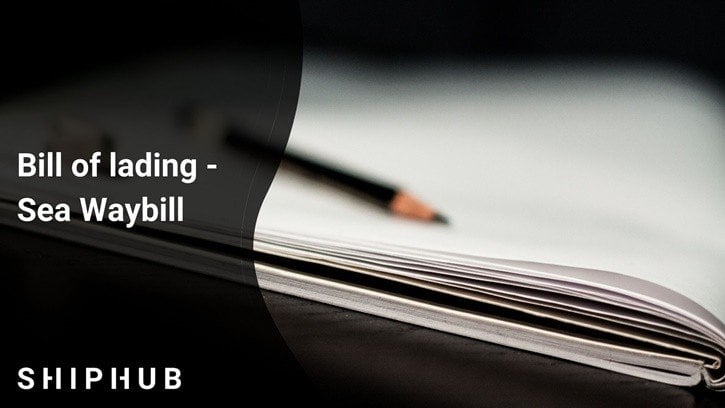Correctly filled transport documents are essential for the implementation of any international transport. Furthermore, each of the transport branches has its own pattern of the bill of landing. Maritime law distinguishes charter part, a note of booking or bill of lading. The last one is one of the most important in the case of international maritime transport.
What is a bill of landing?
Bill of lading (BOL or B / L) is a sea consignment note, a document confirming the receipt of a specific cargo on a ship. The holder of this document may pick up the sent load at the destination port. Above all, it is not a contract for the carriage of goods/cargo between the carrier and the shipper. The bill of lading is not a contract for carriage, but only proof that the contract was concluded before the load was transferred to the captain. Its conditions should match the terms of the transport contract (charter and booking agreement).
More information
According to Article 131 § 1 of the Maritime Code Act of 18 September 2001 (provisions governing maritime transport): “The bill of lading is also evidence of the cargo designated therein for carriage and is a document proving to dispose of this cargo and its reception”. It is worth remembering that the provisions of the contract of carriage bind the recipient only when the bill of lading refers to them (§ 3 of Article 131 in fine).
It is a transferable document (security that can be traded). It is displayed at the request of the shipper, recipient or bank:
- Straight B/L – transferred to other people by way of assignment of rights
- To order B/L – transferred through an indos (a declaration of the will of the transferor to transfer the given property to another person)
- To bearer B/L – without the recipient’s name, transferred by just handing over to the other person
Types
- Shipped, On Board and Received for shipment
- Ship’s receipt – a document issued to the shipper after accepting the cargo on the ship. Ship’s receipt contains all data concerning the goods transferred from the bill of lading. The first officer/loading officer sign Ship’s receipt:
- Clean Bill of Landing – it does not detect defects of the transported goods, its packaging is not checked.
- Foul, Claused Bill of Landing – contains restrictive notes that have been negotiated by the carrier.
- Liner Bill of Landing and Bill of Landing to be used with charter-party
- Electronic Bill of Landing
- Through Bill of Lading
- Transshipment Bill of Landing
If we use the services of a forwarding company, we may receive bills of lading issued directly by the shipowner/sea carrier, i.e., Master Bill of Lading (M / BL). It may happen that a Bill of Lading (H / BL) will be delivered to our hands, which we must provide and deposit at the forwarding agent’s office at the destination port, and then he will contact the shipowner to deliver the container or goods from the port
The process of issuing a bill of lading
After accepting the products to the ship, the carrier is obliged to issue a bill of lading at loader’s request. If earlier the ship’s receipt has been issued for this load, the carrier may make the release of the bill of lading dependent on their return. It provides proof of acceptance of the cargo to the ship for transport and is a document proving that the cargo is to be handled and picked up. The document is issued by a bill of lading instruction received from the shipper/exporter or based on the entries contained in the letter of credit.
What must the Bill of Lading contain?
Bill of lading must contain:
- the carrier’s designation;
- the shipper’s designation;
- designation of the recipient or statement that the bill of lading was issued on behalf of or bearer;
- name of the ship;
- specification of the cargo with its type and – as the case may be – its measure, volume, number of items, quantity or weight;
- determining the external condition of the load and its packaging;
- main signs necessary to establish the identity of the cargo, provided by the shipper in writing before loading, if they were printed or otherwise preserved on particular items of cargo or its packaging;
- an indication of freight and other charges of the carrier, or a statement that their payment has already been made or should take place following the provisions set out in another document;
- name of the place of loading;
- name of the place of unloading or determination of when or where the location of the unloading will be indicated;
- the number of copies of an issued bill of lading;
- date and place of issue of the bill of lading;
- signature of the carrier or master of the ship or other representatives of the carrier.
Proceeding in the case of loss of the bill of lading
This document is issued in several numbered copies, each of which is the original of the document. Usually, there are three originals marked in succession 1/3, 2/3 / and 3/3. The number of copies is unlimited, it depends on the client’s requirements, but usually, 5-6 copies are printed. A bill of lading is security, and in the case of its loss, the container is stopped by the carrier until the bill of lading is delivered. This is related to the need to pay the following costs of cargo in the port.
More about it
The loss of the original sea waybill requires additional complicated, expensive and long-lasting actions by the exporter’s shipper. It also involves the presentation of perpetuation or long-term bank guarantees to the carrier (shipowner) to deliver the container/goods to the recipient without presenting the original Bills of Lading. If the courier company has lost the bills of lading, you should immediately contact them and request documents. If the fault lies on the other side, please contact the shipping carrier and determine what documents you need to deliver the cargo. Usually, these are bank guarantees and payment of a specific sum of money.





